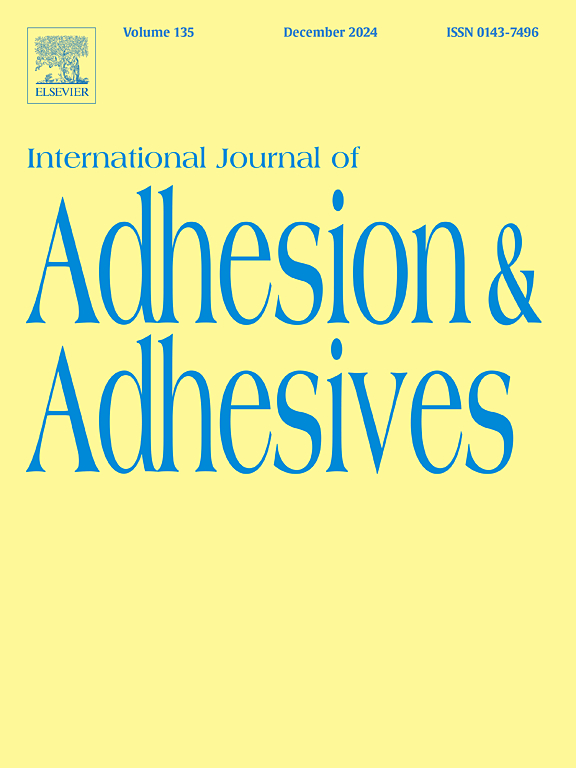Waterborne polyurethane adhesives grafted with carbon dots for enhancing dispersion, cohesion, and adhesion
IF 3.2
3区 材料科学
Q2 ENGINEERING, CHEMICAL
International Journal of Adhesion and Adhesives
Pub Date : 2025-04-09
DOI:10.1016/j.ijadhadh.2025.104031
引用次数: 0
Abstract
Carbon dots (CDs) possess abundant functional groups on their surfaces and can be easily modified, allowing for covalent bonding with waterborne polyurethane (WPU) to create eco-friendly adhesives that exhibit both high cohesion and strong adhesion. However, as a type of nanofiller, CDs often aggregate, hindering effective dispersion. To address this dispersion challenge and enhance the properties of WPU adhesives, CDs were chemically grafted onto the macromolecular chains of WPUs using a silane coupling agent (KH550) as a linking agent. This method improved the adhesion strength of the resulting WPU nanocomposite adhesives, demonstrating the scientific validity of the approach. The successful grafting was confirmed through Fourier transform infrared spectroscopy, X-ray photoelectron spectroscopy, and energy-dispersive spectroscopy. Optimizing the material ratios between the silane coupling agent and CDs significantly reduced CD aggregation in the WPU adhesives, as shown by scanning electron microscopy images that indicated efficient dispersion of the CDs. Malvern particle size analysis and thermogravimetric analysis revealed that when the CDs-to-KH550 mass ratio was 1:10, the water dispersion particle size of silane-modified CDs (KCD) decreased from 447.7 nm to 160.0 nm, and the total weight loss reduced from 53.07 % to 35.55 %. Furthermore, the adhesion properties of WPU adhesives modified with KCDs (KCD-WPU) were notably enhanced. The U-peel strength of the KCD-WPU adhesive on the steel test sheet increased by 31.8 %–510 N m−1 when the KCD content was 0.1 wt.%. The tensile strength of the KCD-WPU adhesive was 62.6 % greater than that of the original WPU adhesive. We proposed a mechanism for the improvement of properties in WPU adhesives grafted with a small amount of CDs. This research presents an effective solution to the agglomeration of CDs in WPU adhesives, thereby enhancing both cohesive and adhesive strength. This study lays the groundwork for designing high-performance WPU adhesives.

接枝碳点的水性聚氨酯粘合剂可增强分散性、内聚力和粘合力
碳点(cd)在其表面具有丰富的官能团,可以很容易地进行修饰,从而与水性聚氨酯(WPU)形成共价键,从而创造出具有高凝聚力和强附着力的环保粘合剂。然而,作为一种纳米填充剂,CDs经常聚集,阻碍了有效的分散。为了解决这一分散问题并提高WPU粘合剂的性能,利用硅烷偶联剂(KH550)作为连接剂,将CDs化学接枝到WPU的大分子链上。该方法提高了WPU纳米复合胶粘剂的粘接强度,证明了该方法的科学有效性。通过傅里叶变换红外光谱、x射线光电子能谱和能量色散光谱证实了接枝的成功。优化硅烷偶联剂和CDs之间的材料比例可以显著降低WPU粘合剂中CD的聚集,扫描电镜图像显示CD的有效分散。Malvern粒度分析和热重分析表明,当cd - kh550质量比为1:10时,硅烷改性cd (KCD)的水分散粒径从447.7 nm减小到160.0 nm,总失重从53.07%减小到35.55%。此外,kcd改性后的WPU胶粘剂(KCD-WPU)的粘接性能显著提高。当KCD含量为0.1 wt.%时,KCD- wpu胶粘剂在钢板上的u型剥离强度提高31.8% -510 N m−1。KCD-WPU胶的抗拉强度比原WPU胶提高了62.6%。我们提出了一种改善少量镉接枝WPU胶粘剂性能的机理。本研究提出了一种有效的解决WPU胶粘剂中cd团聚的方法,从而提高了胶粘剂的内聚性和粘接强度。本研究为高性能WPU胶粘剂的设计奠定了基础。
本文章由计算机程序翻译,如有差异,请以英文原文为准。
求助全文
约1分钟内获得全文
求助全文
来源期刊

International Journal of Adhesion and Adhesives
工程技术-材料科学:综合
CiteScore
6.90
自引率
8.80%
发文量
200
审稿时长
8.3 months
期刊介绍:
The International Journal of Adhesion and Adhesives draws together the many aspects of the science and technology of adhesive materials, from fundamental research and development work to industrial applications. Subject areas covered include: interfacial interactions, surface chemistry, methods of testing, accumulation of test data on physical and mechanical properties, environmental effects, new adhesive materials, sealants, design of bonded joints, and manufacturing technology.
 求助内容:
求助内容: 应助结果提醒方式:
应助结果提醒方式:


